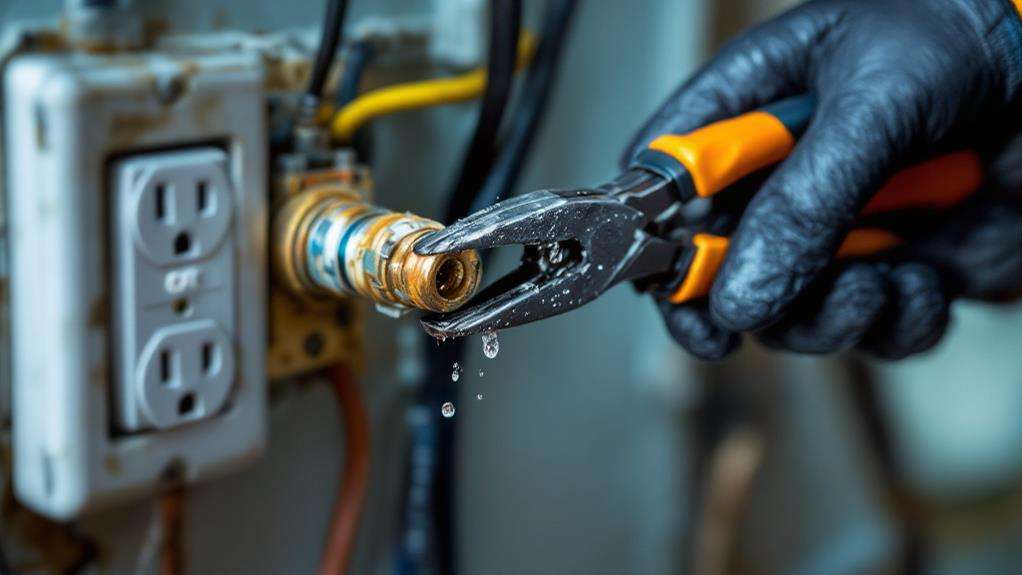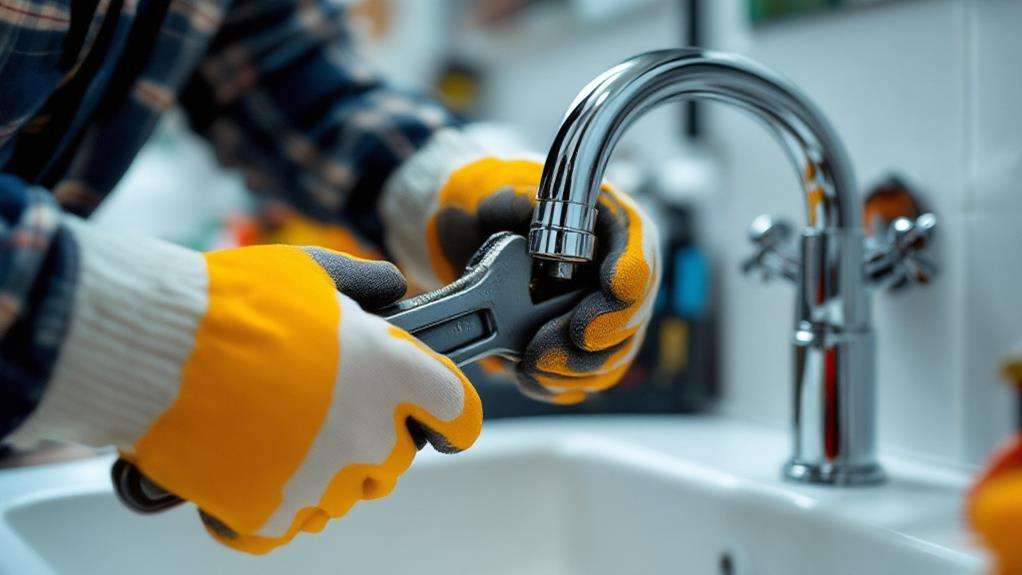Top Safety Tips When Using Plumbing Tools at Home
When using plumbing tools at home, prioritize safety by wearing proper protective gear like goggles, gloves, and non-slip shoes. Always inspect your tools before use, checking for damage or wear. Guarantee electrical safety by shutting off power and using GFCI-protected outlets. Keep your work area clean, organized, and well-lit to avoid accidents. Handle tools correctly, following manufacturer's instructions and using the right tool for each task. Know your limits and don't hesitate to call a professional for complex issues. By following these top safety tips, you'll be better equipped to tackle your plumbing projects with confidence and care.
Wear Proper Protective Equipment
Your body's safety is paramount when working with plumbing tools. To protect yourself from potential hazards, it's extremely important to wear proper protective equipment. Start with safety goggles to shield your eyes from debris and splashes that can cause serious injury. Don't forget to use heavy-duty gloves to guard your hands and arms against sharp edges and hot surfaces you might encounter.
When it comes to foot protection, opt for non-slip shoes with steel toes. They'll prevent foot injuries from falling objects and help you maintain stability on slippery surfaces. To avoid respiratory problems caused by inhaling harmful fumes or particles, use a respirator or face mask. This safety gear is essential when working with chemicals or in poorly ventilated areas.
Lastly, wear coveralls or long sleeves to cover your skin and prevent exposure to harmful chemicals. By taking these safety precautions and using the right safety gear, you'll greatly reduce the risk of accidents and injuries. Remember, proper safety measures are an investment in your well-being. Don't compromise on safety when working with plumbing tools – your health depends on it.
Inspect Tools Before Use
Before diving into any plumbing project, it's crucial to thoroughly inspect your tools. This important step helps protect your health and safety while reducing the risk of accidents in your work area. By taking the time to inspect tools before use, you'll identify potential safety hazards and ensure your equipment is in proper working condition.
To keep your plumbing system in top shape and avoid serious risks, follow these crucial inspection steps:
- Visually examine each tool for cracks, damage, or signs of wear
- Check cutting edges, blades, and bits for sharpness and good condition
- Clean tools thoroughly, removing any debris or residue
- Test adjustable tools to confirm proper operation
Don't forget to inspect your power tools as well. Wear appropriate protective gear while conducting these checks. If you find any damaged or unsafe tools, replace them immediately rather than attempting to use them. Remember, using faulty equipment can lead to accidents and injuries. By prioritizing tool inspection, you'll create a safer work environment and improve the quality of your plumbing projects. Make this practice a habit before every job to guarantee your safety and the longevity of your tools.
Ensure Proper Electrical Safety

While inspecting your tools is important, it's equally vital to prioritize electrical safety when working with plumbing. Water and electricity can be a dangerous combination, so you must take proper precautions to secure your safety.
Before tackling any plumbing issues involving electrical wiring, always shut off the power at the circuit breaker. This step is indispensable for your protection when working on fixtures connected to the electrical system. Additionally, when using power tools near water, only plug them into GFCI-protected outlets that are properly grounded. These outlets help prevent electric shock by quickly cutting off power if they detect a ground fault.
Inspect your electrical devices and power tools regularly for any signs of damage, such as frayed cords or exposed wiring. If you notice any issues, discontinue use immediately and replace or repair the tool. Remember to keep your hands dry when handling plumbing pipes or fixtures to avoid the risk of electric shock. If you're unsure about the safe use of electricity near your water supply or plumbing system, don't hesitate to consult a licensed electrician. Proper plumbing safety practices, including the use of shut-off valves and following electrical precautions, will help you avoid potentially dangerous situations.
Maintain Clean Work Area
Cleanliness is paramount when it comes to plumbing safety. Maintaining a clean work area not only improves efficiency but also greatly reduces the risk of accidents. As you work on your plumbing project, keep your workspace free from clutter and debris to prevent tripping hazards. Immediately wipe up any spills or standing water to avoid slipping, which can lead to serious injuries.
To guarantee a safe working environment, follow these key steps:
- Clear your work area of unnecessary items and organize your tools and materials for easy access.
- Use non-slip mats or rugs in areas prone to water accumulation, such as near sinks or bathtubs.
- Provide adequate lighting in your workspace to clearly see what you're doing and identify potential hazards.
- Regularly clean up as you work, disposing of debris and wiping surfaces to maintain a tidy environment.
Handle Tools Correctly

Proper tool handling is the next key factor in plumbing safety. When working on DIY plumbing projects, it's essential to use the right tool for each task and handle it correctly. Always read the manufacturer's instructions before using any new tool. Protect your hands by wearing appropriate gloves, especially when dealing with sharp edges or potentially hazardous materials.
To stay safe during plumbing repairs, maintain a firm grip on your tools and keep your fingers away from moving parts. When using power tools, make sure they're in good condition and properly grounded. Don't force tools or use them for purposes they weren't designed for. Protect your eyes with safety goggles, particularly when working around pipes and fixtures that may spray water or debris.
When lifting heavy tools or materials, use proper lifting techniques to avoid back injuries. Bend your knees, keep your back straight, and lift with your legs. If a tool or object is too heavy, ask for help or use mechanical aids. By following these plumbing safety tips, you'll considerably reduce the risk of accidents and injuries while working on your home's plumbing system.
Know Your Limits
Safety-conscious DIYers understand the importance of knowing their limits when tackling plumbing projects. To protect yourself from plumbing accidents and guarantee safety, it's indispensable to make sure you know what you can handle. While minor plumbing maintenance tasks are often within reach, more complex issues require professional help.
Safety-conscious DIYers understand the importance of knowing their limits when tackling plumbing projects. To protect yourself from plumbing accidents and ensure safety, it's crucial to make sure you know what you can handle. While minor plumbing maintenance tasks are often within reach, more complex issues require professional help.
- Assess your skills honestly: Be realistic about your plumbing knowledge and experience.
- Research the project: Understand the complexity and potential risks involved.
- Evaluate your tools: Confirm you have the right equipment for the job.
- Consider time constraints: Don't rush into a project you can't complete safely.
If you're unsure about a plumbing task, it's always better to err on the side of caution and contact Professional plumbers. They have the acumen and specialized tools to handle complex issues safely and efficiently. Remember, attempting work beyond your capabilities can lead to costly mistakes or even injuries. By knowing your limits and seeking help when needed, you'll protect yourself and your home while guaranteeing quality plumbing work.

